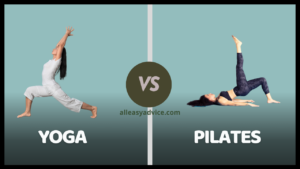
Physical Benefits Of Yoga
Yoga is a powerful practice that offers numerous physical benefits. From increased flexibility and strength to improved posture and balance, the impact of regular yoga practice on the body is truly remarkable. Additionally, yoga enhances respiratory function, allowing practitioners to breathe more deeply and efficiently. These physical benefits of yoga contribute to overall wellness and can have a profound impact on one’s quality of life.Also Read: Pilates vs Lagree: Which Fitness Method Will Give You the Best Results?
Increased flexibility and strength
One of the key physical benefits of yoga is increased flexibility. Through a series of poses and stretches, yoga helps to lengthen and stretch the muscles, making them more supple and improving overall flexibility. This increased flexibility not only aids in everyday activities but also reduces the risk of injury. Yoga also helps to build strength, particularly in the core muscles. The practice of holding poses and flowing through sequences requires engaging and activating the muscles. From warrior poses that strengthen the legs to plank poses that target the core, yoga helps to build overall body strength.Improved posture and balance
Regular practice of yoga can have a profound impact on one’s posture and balance. Many yoga poses focus on aligning the body and correcting imbalances. This helps to improve overall posture and alignment, reducing the strain on the spine and joints. Yoga also enhances balance through its focus on stability and proprioception. Balancing poses such as tree pose and warrior III require concentration and muscle engagement, improving balance over time. Enhancing balance not only promotes better posture but also reduces the risk of falls and injuries.Enhanced respiratory function
Another significant physical benefit of yoga is enhanced respiratory function. The combination of deep breathing techniques and specific poses that open and expand the chest helps to improve lung capacity and oxygen intake. Through regular practice, yoga teaches practitioners to breathe more deeply and fully, improving respiratory efficiency. This can have a positive impact on overall energy levels, stamina, and endurance. As breathing becomes more efficient, the body is better able to eliminate toxins and increase oxygen flow, resulting in a healthier respiratory system. Incorporating yoga into your fitness routine can bring about remarkable physical benefits, such as increased flexibility and strength, improved posture and balance, and enhanced respiratory function. These benefits not only improve physical well-being but also contribute to overall health and vitality. So why wait? Roll out your mat and begin experiencing the transformative power of yoga on your body today.Mental Benefits Of Yoga
Yoga is not just a physical practice, but a holistic discipline for the mind, body, and spirit. Along with its numerous physical benefits, practicing yoga also provides a wide range of mental benefits. From stress reduction and relaxation to improved focus and concentration, these mental benefits can greatly enhance your overall well-being. Let’s explore some of the key mental benefits that yoga offers:Stress Reduction and Relaxation
In today’s fast-paced world, stress is an all too common experience. Thankfully, practicing yoga can help combat the effects of stress and promote deep relaxation. Through a combination of gentle movements, controlled breathing, and meditation, yoga triggers the body’s relaxation response, calming the mind and reducing stress levels. By practicing yoga regularly, you can create a safe and nurturing space in which to let go of tension and release stress. As you flow through different yoga poses, your body’s stress hormone, cortisol, reduces while feel-good endorphins and serotonin increase, leaving you feeling more relaxed and at ease.Also Read: Yoga vs Stretching: Which is More Effective for Flexibility and Strength?
Improved Focus and Concentration
If you often find your mind wandering or struggle to concentrate on tasks, yoga can help sharpen your focus and increase your ability to concentrate. The mindful and deliberate movements in yoga require you to stay present in the moment, shifting your attention away from distracting thoughts and external stressors. As you move through each pose and pay attention to your body’s sensations and breath, you cultivate a deep sense of focus and concentration. The regular practice of yoga enhances your ability to stay centered and present, both on and off the mat.Increased Mindfulness and Self-Awareness
In our fast-paced, technology-driven world, it’s easy to feel disconnected from ourselves and the present moment. However, yoga can help us reconnect with our bodies, thoughts, and emotions, leading to increased mindfulness and self-awareness. Through the practice of yoga, you learn to listen to your body, honor its limitations, and be fully present in each moment. This cultivation of self-awareness extends beyond the physical practice, allowing you to become more in tune with your thoughts, emotions, and choices in everyday life. By regularly practicing yoga, you develop a greater sense of mindfulness, which can help you navigate the challenges and demands of life with more clarity and intention.Physical Benefits Of Pilates
When it comes to improving overall physical fitness, Pilates is often considered one of the most effective and efficient forms of exercise. By combining gentle movements with focused breathing techniques, Pilates is designed to strengthen the body, enhance flexibility, and promote proper alignment. In this blog post, we will explore the various physical benefits of Pilates, focusing on core strength and stability, improved body alignment and posture, as well as increased muscle tone and flexibility.Core Strength and Stability
Pilates places a strong emphasis on building core strength and stability. The core, which consists of the muscles in your abdomen, back, and pelvic floor, plays a fundamental role in supporting the spine and maintaining overall balance and stability. Through a series of controlled and precise movements, Pilates targets and activates these core muscles, leading to improved strength and stability.Improved Body Alignment and Posture
Poor body alignment and posture can have detrimental effects on your overall well-being, leading to issues such as back pain, muscle imbalances, and joint discomfort. Luckily, Pilates can help address these concerns. By focusing on proper alignment and engaging the core muscles, Pilates helps you develop a heightened sense of body awareness and teaches you to maintain correct posture both during exercise and in everyday activities. The result is improved body alignment and enhanced posture that can alleviate discomfort and promote long-term musculoskeletal health.Also Read: Yoga vs Meditation: Which Practice is Right for You?
Increased Muscle Tone and Flexibility
Another notable physical benefit of Pilates is the development of increased muscle tone and flexibility. Through a combination of stretching and strengthening exercises, Pilates targets specific muscle groups, working to lengthen and tone the body. This results in leaner muscles and improved flexibility, allowing for a wider range of motion and better overall athletic performance. Whether you are an athlete looking to enhance your performance or simply aiming to feel stronger and more flexible in your day-to-day life, Pilates can help you achieve these goals.Mental Benefits Of Pilates
Stress relief and improved mental well-being
One of the key mental benefits that Pilates offers is stress relief. In this fast-paced world, stress has become an inevitable part of our lives. Pilates provides a much-needed escape from the daily grind, allowing you to focus on your mind and body connection. By engaging in Pilates exercises, you can release tension, reduce anxiety, and calm your mind. The controlled movements and deep breathing techniques promote mindfulness, helping you be present in the moment and let go of unnecessary worries.Enhanced body awareness and coordination
Another significant mental benefit of practicing Pilates is the enhanced body awareness and coordination it cultivates. Pilates exercises require a connection between your mind and body, as you consciously engage your muscles and move with precision. Through regular practice, you gradually develop a heightened sense of body awareness, which can greatly improve your posture, alignment, and overall movement patterns. This increased awareness carries over into your daily life, allowing you to move with grace and efficiency, and improving your coordination in various activities.Increased self-confidence and body positivity
Pilates isn’t just about physical strength and flexibility; it also has a profound impact on your mental and emotional well-being. As you consistently challenge yourself and progress in your practice, you’ll notice a boost in self-confidence. The accomplishments and milestones you achieve in Pilates can translate into increased self-esteem and a positive body image. Pilates encourages you to appreciate your body’s capabilities and focus on what it can do, rather than any perceived flaws. This shift in mindset fosters body positivity and self-acceptance, allowing you to embrace yourself wholeheartedly and radiate confidence from within.Origins And Principles
The origins and principles of Yoga and Pilates are distinct, reflecting their different ancient practices and modern applications.
Ancient practice and spiritual roots of Yoga
Yoga has a rich history dating back thousands of years and originating in ancient India. It was developed as a spiritual discipline aimed at achieving unity between the mind, body, and spirit. Yoga encompasses a holistic approach to wellness, integrating physical postures (asanas), breathing exercises (pranayama), meditation, and ethical principles in one’s lifestyle. It emphasizes self-awareness, mindfulness, balance, and the connection between oneself and the universe.Modern and therapeutic origins of Pilates
Pilates, on the other hand, is a more recent practice, developed by Joseph Pilates in the early 20th century. Originally designed as a rehabilitative method, Pilates focused on strengthening the body’s core muscles to improve overall stability, flexibility, and posture. It incorporates controlled movements, mindful breathing, and the use of specialized equipment like the Reformer and Cadillac. Over time, Pilates has evolved into a popular exercise method known for its effective body conditioning and injury prevention benefits. In summary, while Yoga has ancient spiritual roots and promotes overall well-being through the integration of physical, mental, and spiritual practices, Pilates emerged as a modern therapeutic system aimed at improving physical strength, flexibility, and postural alignment. Both disciplines have their own unique origins and principles, offering practitioners distinct paths toward physical and mental health.Also Read: Yoga Vs Running: A Comparative Analysis of the Physical, Mental, and Emotional Benefits
Focus And Techniques
Both Yoga and Pilates are popular forms of exercise known for their numerous physical and mental health benefits. While they share some similarities, they also have distinct focus and techniques that set them apart.The mind-body connection and holistic approach of Yoga
Yoga, an ancient practice that originated in India, focuses on establishing a strong mind-body connection. It aims to bring harmony and balance to all aspects of our being – physical, mental, and spiritual. Yoga practitioners engage in a variety of postures, known as asanas, combined with controlled breathing exercises, known as pranayama. These postures and breathing techniques promote flexibility, strength, and relaxation. The holistic approach of Yoga encourages self-reflection, mindfulness, and inner peace. It teaches us to be present in the moment and to listen to our bodies.Core strength and controlled movements of Pilates
Pilates, developed by Joseph Pilates in the early 20th century, focuses on building core strength, stability, and flexibility. The exercises in Pilates are performed in controlled movements that target specific muscle groups, particularly the deep muscles of the abdomen and back. These exercises often involve the use of specialized equipment or can be performed on a mat. Pilates emphasizes the correct alignment and posture of the body, helping to improve overall body awareness and coordination. It is especially beneficial for individuals looking to enhance their core strength and improve their posture.Equipment And Props
Equipment and Props When it comes to practicing Yoga and Pilates, there are some key differences in the equipment and props used. Yoga primarily relies on minimal equipment and utilizes the body’s own weight for resistance and support, whereas Pilates incorporates various apparatus and props to enhance the practice.Minimal equipment and use of body weight in Yoga
In Yoga, the focus is on the connection between the mind, body, and breath, and the equipment used is typically minimal. Whether you’re practicing Hatha, Vinyasa, or Ashtanga Yoga, all you really need is a yoga mat. This simple yet essential prop provides the necessary cushioning and grip on the floor, ensuring stability and comfort during poses. Yoga practitioners also rely on their own body weight to create resistance and develop strength. Poses such as Downward Facing Dog, Plank, and Warrior poses engage multiple muscle groups and help build core strength without the need for additional equipment. This minimalist approach encourages practitioners to cultivate a deeper awareness of their bodies and inner selves.Utilization of apparatus and props in Pilates
Pilates, on the other hand, employs a wide range of apparatus and props to enhance the movements and engage specific muscle groups. The most commonly used apparatus include the Reformer, Cadillac, and Wunda Chair, which provide resistance through springs and pulleys to challenge and strengthen the body. These apparatus help align the body and improve posture, while also providing support and stability during exercises. In addition to the apparatus, Pilates also incorporates various props such as resistance bands, stability balls, and magic circles to add variety and deepen the intensity of the exercises. These props assist in targeting specific muscle groups, increasing flexibility, and improving overall body awareness. They offer modifications and variations suitable for practitioners of all levels, making Pilates a versatile and adaptable form of exercise. So, while Yoga focuses on using minimal equipment and relying on body weight, Pilates incorporates a range of apparatus and props to refine and amplify the practice. Whether you prefer the simplicity of Yoga or the versatility of Pilates, both disciplines offer unique benefits for the mind, body, and soul.Style And Intensity
When it comes to choosing between Yoga and Pilates, one of the essential aspects to consider is style and intensity. Both forms of exercise have their unique styles and variations that cater to different fitness goals and preferences. Understanding the variations in Yoga styles and intensities, as well as the different methods and levels of difficulty in Pilates, can help you determine which practice suits you best for achieving your desired fitness outcomes.Variations of Yoga styles and intensities
Yoga, an ancient practice originating in India, encompasses a wide range of styles and intensities. The diverse options available make it possible for anyone, regardless of fitness level, to find a Yoga style that suits their needs. Here are some popular Yoga styles and their corresponding intensities:
| Yoga Style | Intensity Level |
|---|---|
| Hatha Yoga | Moderate |
| Ashtanga Yoga | High |
| Vinyasa Yoga | Medium to High |
| Bikram Yoga (Hot Yoga) | High |
| Restorative Yoga | Low |
Different Pilates methods and levels of difficulty
Pilates, developed by Joseph Pilates, focuses on improving core strength, flexibility, and body alignment. While there are various methods of Pilates, each with its own approach and exercises, the common goal is to promote overall body stability and control. Here are some popular Pilates methods and their levels of difficulty:- Mat Pilates: This method is performed on the floor using body weight as resistance. It is suitable for all fitness levels and provides a foundation for other Pilates methods.
- Reformer Pilates: Using a specialized machine called a reformer, this method adds resistance to exercises, making them more challenging. It offers numerous variations and difficulty levels to accommodate different fitness levels.
- Clinical Pilates: Often used in rehabilitation settings, clinical Pilates is tailored to individuals with specific injuries or conditions. It focuses on individualized exercises to aid recovery and improve functional movement.
Health Goals And Preferences
When it comes to choosing a fitness routine, there are various factors to consider, including your health goals and preferences. Two popular options that often come up are Yoga and Pilates. Both these practices provide numerous benefits for overall well-being, but they differ in their approach and focus. In this blog post, we will explore the health goals and preferences that Yoga and Pilates cater to, allowing you to make an informed decision.Weight loss and toning
If your primary health goal is weight loss and toning, both Yoga and Pilates can be effective disciplines to incorporate into your routine. However, the approaches they take differ:- Yoga: While Yoga may not be as intense in terms of burning calories as some high-intensity workouts, it can contribute to weight loss by increasing mindfulness and promoting a healthier lifestyle. The flowing sequences and asanas (poses) in Yoga engage various muscle groups, leading to toning and strengthening of the body.
- Pilates: Pilates, on the other hand, is well-known for its focus on core strength and muscle toning. The exercises in Pilates target specific muscle groups, including the abdominals, glutes, and back, helping to improve overall body strength and posture. This can contribute to a leaner and more toned physique.
Rehabilitation and injury prevention
For individuals seeking rehabilitation or injury prevention, both Yoga and Pilates can provide valuable benefits:- Yoga: With its emphasis on flexibility, balance, and alignment, Yoga can help in the recovery of common injuries, such as muscle strains and joint issues. The gentle and controlled movements in Yoga can promote healing and strengthen the body, reducing the risk of future injuries.
- Pilates: Pilates is often recommended for rehabilitative purposes due to its low-impact nature and focus on controlled movements. The exercises in Pilates are designed to target and strengthen specific muscles, aiding in injury prevention and improving overall stability.
Stress relief and mental well-being
Beyond physical health, both Yoga and Pilates offer significant benefits for stress relief and mental well-being:- Yoga: Yoga is known for its harmonization of the mind, body, and spirit. Through deep breathing, meditation, and mindfulness, Yoga can help reduce stress, promote relaxation, and improve mental clarity. The practice of Yoga encourages self-awareness and cultivates a sense of calm and balance.
- Pilates: While Pilates primarily focuses on physical fitness, the mind-body connection it emphasizes can also contribute to stress reduction. The concentration required during Pilates sessions can help individuals disengage from everyday worries and promote a sense of mental well-being.
Accessibility And Availability
One important consideration when deciding between yoga and Pilates is the accessibility and availability of studios, classes, and equipment. Both yoga and Pilates have gained popularity in recent years, making it easier than ever to find a nearby studio or class to attend. However, there are a few differences to note when it comes to accessibility and availability.Yoga Studios and Classes
Yoga studios and classes can be found in almost every city and town, making it widely accessible to individuals of all fitness levels. Whether you’re a beginner or an advanced yogi, there is likely a yoga class that suits your needs. The variety of yoga styles is another factor that contributes to the accessibility of yoga. From gentle Hatha yoga to more intense Vinyasa or Power yoga, there is a style suitable for everyone. In addition, many yoga studios offer classes at different times throughout the day, allowing individuals to find a class that fits into their schedule. Some popular yoga studios include:| Studio Name | Location | Website |
|---|---|---|
| Bliss Yoga Studio | New York City | blissyogastudio.com |
| Sunshine Yoga | Los Angeles | sunshineyoga.com |
| Balance Yoga | Chicago | balanceyoga.com |
Pilates Studios and Equipment
While Pilates is becoming more popular, it may not be as widely available as yoga. Pilates studios are more concentrated in larger cities, making it potentially less accessible for individuals in rural areas. However, online platforms and virtual classes have made Pilates more accessible to people who may not have a local studio nearby. When it comes to equipment, Pilates requires specialized machines, such as reformers and Cadillacs, which may not be as readily available as yoga props like mats and blocks. Pilates equipment can be expensive and take up more space, making it less practical for home use. However, many Pilates studios provide the necessary equipment for their classes. Some popular Pilates studios include:| Studio Name | Location | Website |
|---|---|---|
| Core Pilates | San Francisco | corepilates.com |
| Pilates Plus | Miami | pilatesplusmiami.com |
| Centered Body Pilates | Denver | centeredbodypilates.com |
Safety And Proper Form
When it comes to practicing yoga or Pilates, safety and proper form are paramount. Both disciplines offer numerous health benefits, but it is crucial to ensure that you are performing the exercises correctly to avoid any potential injuries. This section will delve into the importance of proper alignment and technique in yoga and Pilates, as well as the guidance provided by qualified instructors.
Importance of proper alignment and technique
The correct alignment and technique in yoga and Pilates are integral to reaping the full benefits of these practices while minimizing the risk of injury. Proper alignment refers to positioning your body correctly in each posture or movement, whereas technique pertains to executing the exercises with precision and control. Here are a few reasons why focusing on proper alignment and technique is crucial:- Promotes better posture: Engaging in yoga or Pilates with proper alignment helps improve your overall posture. By maintaining correct alignment, you avoid unnecessary pressure on your joints, muscles, and ligaments, reducing the likelihood of strain or discomfort.
- Enhances muscle engagement: When you perform yoga or Pilates with the proper technique, you activate the intended muscles effectively, ensuring optimal engagement and strengthening. This targeted approach can lead to improved muscle tone, flexibility, and endurance.
- Avoids strain and injury: Incorrect alignment and technique can lead to strain or injury in certain areas of your body, particularly the spine and joints. By practicing with proper form, you minimize excessive stress on vulnerable areas and distribute the workload evenly throughout your body.
- Maximizes benefits: Yoga and Pilates are renowned for their ability to improve flexibility, core strength, and relaxation. By demonstrating correct alignment and technique, you can fully experience the intended benefits of each posture or movement, allowing you to progress in your practice.
Guidance from qualified instructors
Whether you choose yoga or Pilates, receiving guidance from qualified instructors is essential, when it comes to safety and proper form. Qualified instructors have a deep understanding of the techniques, alignment, and modifications relevant to each exercise, ensuring that you achieve the desired results without compromising your well-being. Here’s why seeking guidance from qualified instructors is beneficial:- Expert knowledge: Qualified instructors possess extensive knowledge of anatomy, physiology, and movement principles. They understand the intricacies of each yoga pose or Pilates exercise, allowing them to guide you through proper alignment and technique.
- Individualized attention: Instructors can provide individualized attention, offering modifications and adjustments tailored to your unique needs and abilities. This personalized guidance ensures that you are performing the exercises safely and effectively, regardless of your level of experience.
- Prevention of injuries: Instructors can identify improper alignment or technique, helping you make necessary adjustments to avoid potential injuries. Their keen eye for detail ensures that you maintain the integrity of each movement, minimizing the risk of strain or unnecessary stress on your body.
- Continual progression: With the guidance of qualified instructors, you can progress steadily in your yoga or Pilates practice. They can introduce new exercises, challenge your abilities, and refine your form, allowing you to deepen your practice and achieve your goals.
Starting With Yoga
When it comes to fitness and wellbeing, Yoga and Pilates are two popular options that offer numerous benefits for both body and mind. In this article, we will focus on Yoga and explore its various aspects, particularly for beginners.Finding the right class or style for beginners
As a beginner, it’s important to find a Yoga class or style that suits your needs and preferences. With a wide variety of Yoga styles available, each with its own focus and intensity, it’s crucial to choose the right one to ensure a positive and enjoyable experience. Here are a few popular Yoga styles suitable for beginners:| Yoga Style | Description |
|---|---|
| Hatha Yoga | A gentle style that focuses on basic postures and breath control, making it ideal for beginners. |
| Vinyasa Yoga | A more dynamic and flowing style that synchronizes breath with movement. Beginners can start with slower-paced Vinyasa classes. |
| Iyengar Yoga | Known for its emphasis on proper alignment and use of props, Iyengar Yoga offers beginners the opportunity to learn the fundamentals in a safe and supported way. |
Gentle poses and modifications for beginners
For beginners, it’s essential to start with gentle poses that help to build a foundation and prevent injuries. Yoga instructors often provide modifications to accommodate individual needs, making the practice accessible to everyone. Here are a few gentle poses and modifications commonly used for beginners:- Child’s Pose (Balasana): This pose helps to relax and stretch the lower back, hips, and thighs. Beginners can use a bolster or blanket under their forehead for added support.
- Mountain Pose (Tadasana): A foundational standing pose that improves posture and alignment. Beginners can use a wall for support and focus on grounding their feet.
- Corpse Pose (Savasana): This restorative pose promotes relaxation and deep rest. Beginners can use props such as blankets or bolsters to ensure comfort.
Starting With Pilates
If you’re new to the world of mind-body exercises, starting with Pilates can be a great way to develop core strength, improve flexibility, and enhance overall body awareness. Pilates, created by Joseph Pilates during the early 20th century, focuses on developing a strong core by targeting the deep muscles of the abdomen and back. It incorporates controlled movements, precise breathing techniques, and an emphasis on alignment for maximum effectiveness.Understanding the Core Principles and Foundations
In order to get the most out of your Pilates practice, it’s essential to understand its core principles and foundations. These principles serve as the building blocks of Pilates and are crucial for proper execution and progression. Here are some key principles to keep in mind:- Centering: Pilates emphasizes the concept of centering, which involves finding and engaging your core muscles. This helps to stabilize the spine and bring balance to the body.
- Control: Unlike other forms of exercise, Pilates is all about control. It focuses on performing movements with precision and mindfulness, ensuring every movement is intentional and purposeful.
- Concentration: Concentration is key in Pilates. By concentrating on each movement and engaging the mind-body connection, you can achieve greater results and improve overall body awareness.
- Precision: Attention to detail is essential in Pilates. The precision of the movements and alignment is what makes Pilates effective in strengthening the body and improving posture.
- Breathing: Proper breathing techniques are integral to Pilates. Breathing deeply and consciously helps to oxygenate the muscles, promote relaxation, and facilitate movement.
- Flow: Pilates encourages a smooth and continuous flow of movement. Transitions between exercises should be seamless, creating a seamless integration of mind and body.
Beginner-friendly Exercises and Modifications
Pilates offers a wide range of exercises suitable for beginners. Whether you’re looking to strengthen your core, improve flexibility, or simply enhance your overall well-being, Pilates has you covered. Here are a few beginner-friendly exercises to get you started:| Exercise | Description |
|---|---|
| The Hundred | Lie on your back, lift your head, neck, and shoulders off the mat, and pump your arms up and down while breathing deeply. |
| Roll-up | Lie on your back with your legs extended, and slowly roll up to a seated position, then roll back down with control. |
| Bridge | Lie on your back with your knees bent and feet flat on the mat. Lift your hips up, creating a straight line from your knees to your shoulders, and lower back down. |




